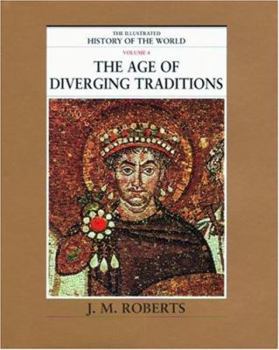The Illustrated History of the World: Volume 4: The Age of Diverging Traditions
(Book #4 in the The Illustrated History Of The World Series)
Select Format
Select Condition 
Book Overview
The Illustrated History of the World is a lavishly illustrated edition of J. M. Roberts's bestselling History of the World. Now completely revised and updated, each volume of this comprehensive reference work traces the tumultuous story of humankind from prehistory to the end of the 20th century. The rise and fall of civilizations; the impact of powerful individuals on world events; the interplay of state and religion; the social and economic factors...
Format:Hardcover
Language:English
ISBN:0195215222
ISBN13:9780195215229
Release Date:February 2002
Publisher:Oxford University Press, USA
Length:192 Pages
Weight:2.45 lbs.
Age Range:8 to 12 years
Grade Range:Grades 3 to 7
Customer Reviews
2 ratings
Highly recommended
Published by Thriftbooks.com User , 21 years ago
This book is the fourth volume in the wonderful Illustrated History of the World Series. Focusing exclusively on the west, this volume covers the Middle East from the Sassasnid Empire through the spread of Islam and on to the rise of the Ottoman Empire. Then, Eastern Europe is examined through the development of the Byzantine Empire, and its influences to the north on Russia and Eastern Europe. Finally, Western Europe is covered, from about 1000 A.D. to the flowering of Medieval Europe. Along the way, the reader is treated to many colorful maps and pictures, and interesting sidebars.This book is another very good, which continues the quality one expects from this series. This is quite an interesting look at an interesting time. I highly recommend this book.
Well-Written and Beautifully Illustrated
Published by Thriftbooks.com User , 22 years ago
The Rise of Islam, The Byzentine Empire, and the Beginnings of Modern Europe The Age of Diverging Traditions is volume four of a ten volume series called The Illustrated History of the World. The first volume covered the origins of the human race through the first civilizations of Mesopotamia and Egypt. The second volume in the series reviewed the early cultures of India and China and then moved on to discuss Greek civilization. The third volume covered the rise and fall of the Roman Empire, from 800 BCE to 600 CE. This fourth volume surveys the rise of Islam, the Arab empires, the decline of the Byzentine Empire, and the beginnings of modern Europe. The book is filled with beautiful color illustrations. Every page has at least one and most are photographs of artifacts, art works, or scenes. The text is well written and emphasizes brief summaries rather than scholarly examination. This makes it a good basic introduction and outline, but may be less useful to someone who wants to look at these subjects in greater depth. The lack of any bibliography of further readings is also a drawback for those wanting to seek more information. A two-page time chart of the period helps to put events in perspective. The chapter contents are confusingly placed at the end of the book, but they are well done and helpful for getting an overview of the author's approach. A two page listing of all the books in the series with their section and chapter titles helps to put the material into the broader view of all world history.If you want an entertaining introduction to the beginnings of Islam, the early Arabic empires, the decline and end of the Byzentine empire, the Mongolian empire of Chingis Khan, the rise of the Ottaman Turks, and the beginnings of Western Europe, this is a great book to read. Surprisingly, you will have to read volume five for an introduction to the Crusades since Roberts only devotes one page to them in this volume. The beginnings of Islam is well treated, even though Muhammad himself is only mentioned in passing. Byzantium's history and influence are well documented and an explanation of the Iconoclasm dispute is well done. The last section on the formation of modern Europe through the rise of Charlemagne, and the increasing influence of the papacy is the most detailed account in the volume.The type face is large and the lines are amply spaced. Couple this with the copious illustrations and the book is actually a very quick read for its size and length. It is a few steps above the approach of Dorling Kindersley books that are predominately illustrations with supporting text. With Roberts, the text is the major part, but the illustrations are definitely more than an after thought. This is a good introduction for the general reader. It is not going to be a lasting reference book that you will turn to again and again. Read it once and move on.






